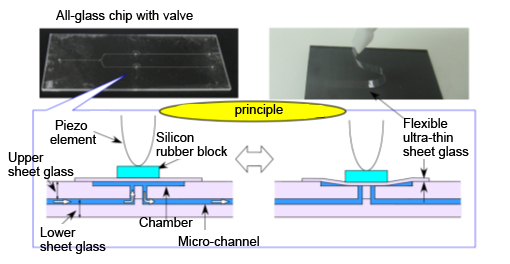Sep. 1, 2013
Electrically operated valve using ultra-thin sheet glass inside an all-glass microchip
RIKEN No.: 08049
Inventors
Yo Tanaka (Laboratory for Integrated Biodevice) and Hiroki Ueda (Laboratory for Synthetic Biology)
Background
Microchips created by machining channels with a width and depth of 1 mm or less on a glass substrate measuring several centimeters square and integrating chemical and biochemical systems are expected to play an important role as compact, high-speed, next-generation devices for next-generation medical diagnosis and other applications. However, glass is a hard substance, so there was the issue that it was extremely difficult to incorporate the valves essential for controlling the fluids in the channels, which meant that the merits of integration could not be fully realized. In contrast, valves can easily be built into microchips made of resin such as polydimethylsiloxane (PDMS) by making use of the flexibility of these materials. However, resin microchips are unsuitable in terms of physical and chemical stability for applications such as manipulation, analysis and detection of organic solvents and gases, or cell patterning that makes use of advanced surface chemical treatment.
Summary
RIKEN researchers therefore conceived the idea of using recently developed ultra-thin sheet glass with a thickness less than 10 μm. This thinness provides characteristics of extremely high flexibility and resistance to breakage, even for glass. By handling this ultra-thin sheet glass, developing original technology for incorporating it into a glass microchip, and mounting piezo elements, we were able to successfully demonstrate a valve inside an all-glass microchip.

Glass microchip with valve using ultra-thin sheet glass, and principle of valve drive
Advantages
- The developed glass valve has an extremely swift response (approximately 0.1 s) and is stable with regards to almost all solvents and solutes. This makes it applicable to general integrated chemical systems, and it is expected to become an extremely useful tool in fields such as medical diagnosis, single cell manipulation, and polymer synthesis.
Applications
- High-speed immunoassay, single cell diagnosis, polymer synthesis, etc.
Reference
- 1.Japanese Patent Application No. 2013-127810, US patent 9073054.
